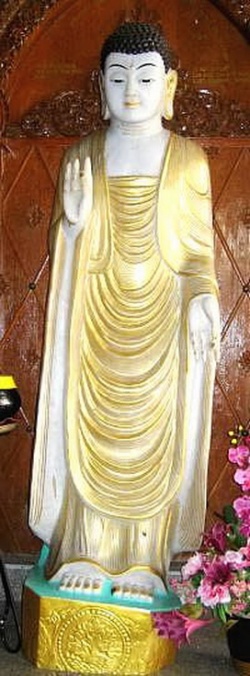True Word school
True Word school
[[[真言宗]]] ( Jpn Shingon-shu)
A Buddhist school in Japan established by Kobo(774-835), also known as Kukai, that follows the esoteric doctrines and practices found in the Mahavairochana and Diamond Crown sutras. The name true word is the rendering in Chinese of the Sanskrit mantra (meaning secret word or mystic formula). In the True Word school, this indicates the words that Mahavairochana Buddha is said to have uttered. The chanting of these secret words is one of the school's basic esoteric rituals for the attainment of enlightenment. The True Word school maintains that Esoteric Buddhism was transmitted from Mahavairochana Buddha to Vajrasattva, and then down through Nagarjuna, Nagabodhi, Chin-kang-chih (Skt Vajrabodhi), Pu-k'ung (Amoghavajra), Hui-kuo, and finally to Kobo. The school also lists eight patriarchs who upheld Esoteric Buddhism: Nagarjuna and Nagabodhi who spread it in India; Chin-kang-chih, Pu-k'ung, and Shanwuwei (Shubhakarasimha) who introduced and established it in China; I-hsing and Hui-kuo who propagated it in China; and Kobowho brought it to Japan and founded the True Word school there.
In 716 the monk Shubhakarasimha brought Esoteric Buddhism from India to Ch'ang-an in China, where he became known as Shanwuwei. Hsüan-tsung, the sixth emperor of the T'ang dynasty, honored and supported Shanwuwei, and his teachings spread widely in China. In 720 Vajrabodhi (Chin-kang-chih) and Amoghavajra (Pu-k'ung) also came from India to Lo-yang in China and introduced more of Esoteric Buddhism.
In 804 Kobo traveled from Japan to Ch'ang-an, where he studied Esoteric Buddhism under Hui-kuo. During his stay there he received the teachings of the Diamond Realm and Womb Realm mandalas. In 806 he returned to Japan with numerous Buddhist scriptures, esoteric mandalas, and ritual implements, and in 809 entered the capital, Kyoto, where he advocated the supremacy of Esoteric Buddhism. In 816 he was granted a tract of land on Mount Koya on which to found a monastery. In 823 Kobowas also given another temple, To-ji, in Kyoto, which became the center of esoteric practice in Japan. In the late thirteenth century, dif-ferences in doctrinal interpretation resulted in the formation of the New Doctrine (Shingi) school, a branch of the True Word school based at Mount Negoro, and the teachings and traditions of Mount Koya and To-ji came to be called the Old Doctrine (Kogi) school.
See also Kakuban; Raiyu; Yakushin.
